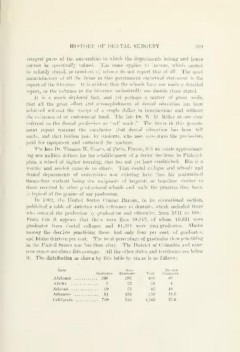Page 439 - My FlipBook
P. 439
lUSTOliY OF DENTAL SUEGERY 399
integral part? of the universities to which the departments belong and hence
cannot be specitieaily valued. The same applies to income, which cannot
be reliably stated, as numbers of schools do not report this at all. The most
unsatisfactory of all the items in this government statistical statement is the
report of the libraries. It is evident that the schools have not made a detailed
report, as the volumes in the libraries undoubtedly are double those stated.
It is a much deplored fact, and yet perhaps a matter of great pride,
that all the great effort and accomplishment of dental education has been
achieved without the receipt of a single dollar in benefactions and without
the existence of an endowment fund. The late Dr. W. D. Miller at one time
referred to the dental profession as "self made."' The items in this govern-
ment report warrant the conclusion that dental education has been self
made, and that tuition paid by students, who now constitute the profession,
paid for equipment and sustained the teachers.
The late Dr. Thomas W. Evans, of Paris, Fi'ance, left an estate approximat-
ing one million dollars for the establishment of a dental institute in Philadel-
phia, a school of higher learning, that has not yet been established. His is a
worthy and needed example to others. Tliat dental colleges and schools and
dental departments of universities now existing have thus far nuiintained
themselves without being the recipients of bequests or benefices similar to
those received by other professional schools and made the progress they have,
is typical of the genius of our profession.
In 1902, the United States Census Bureau, in its educational section,
published a table of statistics with reference to dentists, which included those
who entered the profession by graduation and otherwise, from 1841 to 1901
From this it appears that there were then 28,142, of whom 16,831 were
graduates from dental colleges, and 11,311 were non-gradnates. Alaska
among the dentists practising there, had only four per cent, of graduates,
and Idaho thirteen per cent. The total percentage of graduates then practising
in the United States was less than sixty. The District of Columbia and nine-
teen states are above this aveiage. All the other states and territories are below
The distribution as showoi by tliis table by states is as follows:
it.
State
Alabama ....


